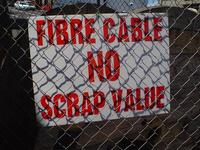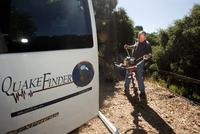-
Redirecting menacing asteroids

Sometime between 2029 and 2036, the asteroid Apophis will come uncomfortably close to Earth; if the asteroid, which weighs forty-six million tons, were to strike Earth, it would cause damage for thousands of miles around the epicenter; scientists propose ways to nudge the menacing asteroid off its current course
-
-
Sector Report for Monday, 22 August 2011: Infrastructure protection
This report contains the following stories.
Plus 1 additional story.
-
-
Cyber experts dispute McAfee's Shady RAT report

Earlier this month, cybersecurity experts discovered a five-year operation that infiltrated U.S. government and UN computer networks; China is believed to be the culprit behind the systematic attacks, dubbed “Operation Shady RAT,” which also hit major defense contractors and private businesses; many within the cybersecurity community are disputing the significance of the finding
-
-
USSI showcases port security system
To help secure U.S. ports and waterways which provide a vital link to the global supply chain, US Seismic Systems Inc. (USSI) has developed an underwater fiber-optic sonar system that detects small craft entering protected areas
-
-
Making rail travel more reliable
U.K. researchers are collaborating with industry to develop novel optical sensors that detect when overhead power lines are likely to fail; the costly disruption to rail travel caused by the breakdown of overhead power lines could thus become a thing of the past
-
-
DHS warns copper thefts on the rise

DHS officials warn that copper thefts from critical infrastructure and key resource sectors in the United States are on the rise; in March, a Port of Houston security guard was arrested for giving his friends and families access to the port, where they allegedly stole more than 22,000 pounds of copper
-
-
Researchers develop controversial earthquake detection network

Researchers at a Silicon Valley company are hard at work developing an experimental network of electromagnetic sensors that could predict large earthquakes as much as two weeks in advance; the theory behind the research is disputed, but Tom Bleier, the inventor and chief engineer behind project QuakeFinder, hopes to prove seismologists wrong
-
-
Bill calls for all utility plant worker background checks
Senator Charles Schumer (D-New York) will introduce new legislation that would require all major utility plants to run background checks on its employees; the bill would require FBI background checks on all employees of all major utility plants, strengthening the current requirement which mandates such checks only at nuclear power plants
-
-
New task force helps protect Port of Virginia
A new border security task force has been launched to help secure the Port of Virginia; the task force is comprised of ten officers and agents from a total of ten local, state, and federal agencies that will be responsible for securing the Port of Virginia against a variety of criminal acts including trade fraud, cargo theft, and the illegal smuggling of drugs, persons, currency, and weapons
-
-
Calls for more stringent standards in wake of increasing storm damage

Researchers from a team funded by the National Science Foundation have examined some of last spring’s massive tornado damage and conclude in a new report that more intensive engineering design and more rigorous, localized construction and inspection standards are needed to reduce property damage and loss of life
-
-
Identifying Canadians from their date of birth, postal code
Researchers find that 97 percent of Canadians can be uniquely identified from their date of birth and postal code; this means that if these to items of information, plus gender, exist in any database, even if it has no names or other identifying information, it would be possible to determine the identity of those individuals birth
-
-
Wire pops lock certified for US defense facilities
The Access Control E-Plex 5800 lock from Swiss company Kaba was described as the first lock certified as meeting new DHS requirements for coded access that keeps track of which contractors or federal workers open which doors; at the DefCon event in Las Vegas, a security expert demonstrated how this high-security lock, certified for use in sensitive U.S. government facilities, can be easily opened with just a piece of wire
-
-
Sector Report for Monday, 8 August 2011: Infrastructure protection
This report contains the following stories.
Plus 1 additional story.
-
-
Market forces to help reduce emission, increase storage of CO2
New computer modeling work shows that by 2100, if society wants to limit carbon dioxide in the atmosphere to less than 40 percent higher than it is today, the lowest-cost option is to use every available means of reducing emissions — including using forests to store carbon
-
-
Dow fined $2.5 million for violations at Michigan chem plant

Due to environmental and safety violations at its chemical plant in Midland, Michigan, Dow Chemical will have to pay $2.5 million in fines; federal inspectors found that the chemical plant violated air, water, and waste regulations between 2005 and 2007
-
- All
- Regional
- Water
- Biometrics
- Borders/Immig
- Business
- Cybersecurity
- Detection
- Disasters
- Government
- Infrastructure
- International
- Public health
- Public Safety
- Communication interoperabillity
- Emergency services
- Emergency medical services
- Fire
- First response
- IEDs
- Law Enforcement
- Law Enforcement Technology
- Military technology
- Nonlethal weapons
- Nuclear weapons
- Personal protection equipment
- Police
- Notification /alert systems
- Situational awareness
- Weapons systems
- Sci-Tech
- Sector Reports
- Surveillance
- Transportation
Advertising & Marketing: advertise@newswirepubs.com
Editorial: editor@newswirepubs.com
General: info@newswirepubs.com
2010-2011 © News Wire Publications, LLC News Wire Publications, LLC
220 Old Country Road | Suite 200 | Mineola | New York | 11501
Permissions and Policies
Editorial: editor@newswirepubs.com
General: info@newswirepubs.com
2010-2011 © News Wire Publications, LLC News Wire Publications, LLC
220 Old Country Road | Suite 200 | Mineola | New York | 11501
Permissions and Policies
